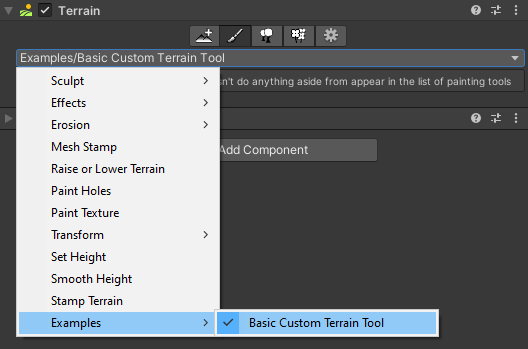2.3 KiB
Create your tool script
Create a new script in your project. Give the script the same file name and class name as the Terrain Tool you want to create. The basis for all Terrain tools is the TerrainPaintTool class in the UnityEditor.TerrainTools namespace. TerrainPaintTool is an abstract generic class.
You must override a few methods to make a functional tool. There are also two functions you must implement, and those are:
| Function | Returns |
|---|---|
| GetName | string Name of the Terrain Tool. Appears in the tool UI. |
| GetDesc | string Description for the Terrain Tool. Appears in the tool UI. |
Here is an example Terrain tool without any additional functionality.
using UnityEngine;
using UnityEditor.TerrainTools;
internal class BasicTerrainTool : TerrainPaintTool<BasicTerrainTool>
{
// Name of the Terrain Tool. This appears in the tool UI.
public override string GetName()
{
return "Examples/Basic Custom Terrain Tool";
}
// Description for the Terrain Tool. This appears in the tool UI.
public override string GetDesc()
{
return "This is a very basic Terrain Tool that doesn't do anything aside from appear in the list of Paint Terrain tools.";
}
public override void OnInspectorGUI(Terrain terrain, IOnInspectorGUI editContext)
{
}
public override void OnRenderBrushPreview(Terrain terrain, IOnSceneGUI editContext)
{
}
public override bool OnPaint(Terrain terrain, IOnPaint editContext)
{
return true;
}
}
The example above is a good starting point to create a custom tool from scratch. Basic Custom Terrain Tool now displays as an option in the Paint Terrain dropdown menu.
If you want to specify a category in the dropdown menu, you can add categories and subcategories such as Category/SubCategory1/SubCategory2/Custom Terrain Tool. Make sure to replace Category, SubCategory1, and SubCategory2 with the actual category and subcategory names you want to use.
The image below shows an Examples category, which contains the Basic Custom Terrain Tool.
